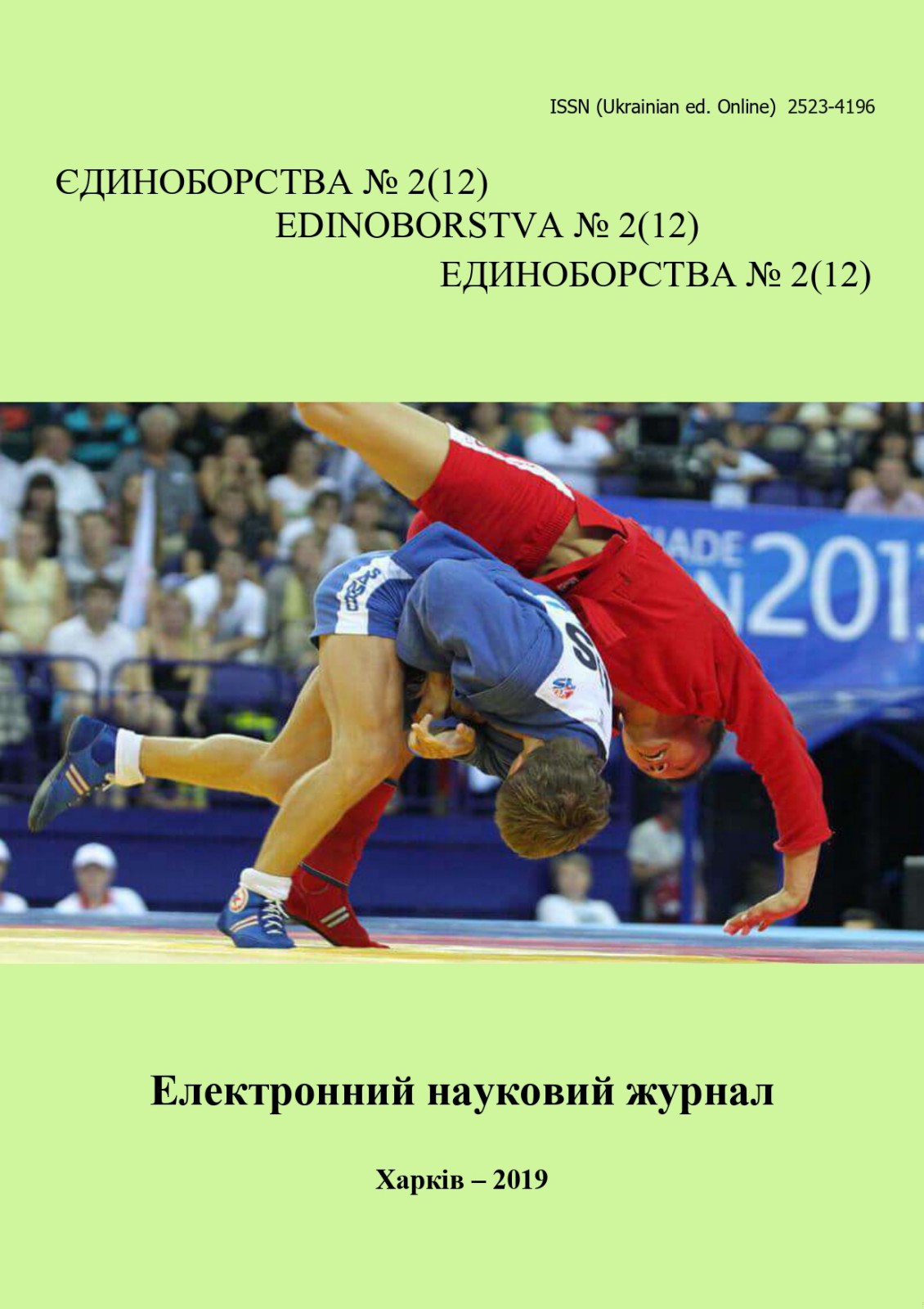Ways to improve dexterity (coordination abilities) of martial arts at the initial preparation stage
Keywords:
wrestlers, agility, coordination abilities, dynamics, developmentAbstract
Purpose: to follow the dynamics of the development of dexterity in children of primary school age, engaged in martial arts at the initial preparation stage. Material and methods: analysis, systematization and synthesis of scientific and scientific-methodical literature; survey of coaches; pedagogical observation of the training process; pedagogical research; mathematical and statistical methods for analyzing quantitative research results. In accordance with the work plan, all athletes, first in the middle and at the end of the study, were tested on five control exercises: shuttle run 4 x 10 m; balance test; tossing and catching the ball three times in advance for the number of times in 10 seconds and two consecutive punches. The study was conducted in three stages: September 2017 - October 2018. Results. Proposed and carried out tests for the detected dexterity wrestlers 6-7 years in the initial training groups. The control study helped to determine the dynamics of the indicators of the development of dexterity. The proposed technique with the use of special exercises and mobile games on the development of dexterity improved performance in percentage terms: shuttle run 4 x 10 m improved by 19,8 % compared with the first stage, in the balance test by 32,9%, catching the ball by 39 %, a three-turn-ahead rate increased by 9 %, punches by 17%. The results of the study confirmed the effectiveness of the use of our chosen method of developing agility in children of primary school age involved in martial arts. Conclusions: The results of the follow-up study of the development of dexterity in the group of fighters of 6-7 years are reliable and can be applied in the practice of coaches. It was determined that the skill exercises should be included in the first third of the training session in short, no more than 15-minute series. It has been established that for effective development of dexterity it is necessary to use games in training activities that require precise coordination of movements and quick coordination of their actions with the actions of partners.
References
Алексєєв, А. Ф., & Алексєєва, І. А. (2016). Навчально-методичний посібник з дзюдо для тренерів-викладачів дитячо-юнацьких спортивних шкіл та спортивних клубів. Харків.
Алексєєв, А. Ф., Ананченко, К. В., & Бойченко, Н. В. (2014). Теорія та методика викладання дзюдо та самбо: навч. посіб. для студенів 3 курсу (за кредитно-модульною системою). ХДАФК, Xарків.
Ананченко, К. В., Бойченко, Н. В., & Панов, П. П. (2017). «Вдосконалення координаційних здібностей юних дзюдоїстів». Единоборства, 4-11.
Волков, Л. В. (2001). Биологические и педагогические основы современных технологий спортивной подготовки детей и молодежи. Варшава.
Волков, Л. В. (2002).Теория и методика детского и юношеского спорта. Киев.
Волков, Л. В. (2015). Вільна боротьба: базова фізична підготовка. Ризо-Графіка, Бориспіль.
Ермаков, С. С., Тропин, Ю. Н., & Бойченко, Н. В. (2016). «Специальная физическая подготовка квалифицированных борцов». Единоборства, 20-22.
Пашков, И. Н. (2008). «Роль сенсорных систем при развитии координационных способностей». Физическое воспитание студентов творческих специальностей, 38-43.
Платонов, В. Н. (2015) Система подготовки спортсменов в олимпийском спорте. Общая теория и ее практические приложения: учебник [для тренеров]: 2 кн. Олимп. лит., Киев.
Романенко, В. А. (2005). Диагностика двигательных способностей. «Новый мир», УКЦентр, Донецк.
Сергієнко, Л. П. (2009). Тестування рухових здібностей школярів. Київ.
Ягело, В. (2002). Теоретико-методические основы системы многолетней физической подготовки юных дзюдоистов. Warszawa – Киев.
Kim, Jeong-Kok. (2012). Taekwondo textbook. Seoul, Seo Lim Publisying Co.
Lee Kyong, M. (2016). Taekwondo.New York.













